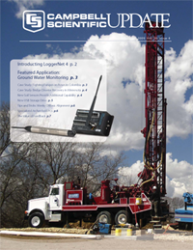On August 1, 2007, the I-35W St. Anthony Falls Bridge over the Mississippi River in Minneapolis, Minnesota, collapsed in the middle of rush hour. What followed was a tremendously cooperative effort to quickly and safely replace the bridge. The instruments and methods used show how instrumentation can be used to increase quality assurance, monitor construction loads, and show traffic and wind-load effects on long-term pier performance. Campbell Scientific's cutting-edge technology is at the core of this complex system.

This first part of a larger program involving the entire bridge pertained to only the Southbound Pier 2 columns and foundations. There, two types of strain gages and thermometers were installed to monitor three phases of the bridge and foundation system:
- Internal concrete curing—measuring temperature of the foundation elements as it is poured and cures.
- Construction loads—monitoring increasing stresses as bridge was built.
- Long-term health—ongoing; comparing loads on bridge during use with baseline load tests. (See photo.)
Two separate data acquisition systems were used to measure the dozens of strain gages. The vibrating wire gages were read with a Campbell Scientific AVW200 and recorded with a CR1000 datalogger. The resistive gages were measured with Campbell Scientific's CR9000X high-speed data acquisition system. Both systems were self-powered with solar panels and deep-cycle batteries, and each system uploaded data to a remote host server via cellular modem. This arrangement allowed the data acquisition systems to operate independently of on-site construction power and communications, and they did not interfere with day-to-day construction activities.
Key aspects to both data acquisition systems were remote data monitoring, program downloading, and reconfiguration as the data acquisition requirements increased and decreased.
This project well demonstrated the benefits of Campbell's AVW200 and the spectral-analysis method for reading vibrating wire sensors. Not only did this project involve a large number of vibrating wire sensors, but the setup was located 5 ft from a 1000-kW generator. Even with the large generator nearby, no data was lost due to noise, and no extra analysis was needed to determine if measurements had been compromised by noise. In fact, the raw data were posted automatically to a publicly available website every 15 minutes, without review or qualification.

